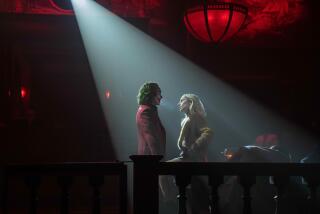Bridled Optimism
It’s no wonder Disney executives are anxious right about now.
A week from today, the studio will release “Mulan”--arguably its riskiest animated feature since 1994’s “The Lion King,” which was also the company’s greatest success.
In its formative stages, “Lion King” was disparaged even inside some quarters at Disney as “the dog project.” Nonbelievers feared it wouldn’t work because it was an unfamiliar story about animals and had no human characters. In the end, the movie defied skeptics by becoming Disney’s most profitable film ever with well over $1 billion in total profit.
“Mulan,” Disney’s 36th animated feature, also is an unconventional approach from the studio’s animation machine. Unlike most Disney animated films, which usually mine well-known stories and fairy tales, “Mulan” is based on a 2,000-year-old Chinese legend virtually unknown to most people in the United States. It follows the adventures of a renegade teenage girl, Mulan, who isn’t driven to find a handsome man to live happily ever after with, but rather to selflessly bring honor to her family.
Directed by veteran Disney animators Barry Cook and Tony Bancroft and produced by Pam Coats, the film follows the teenager as she disguises herself as a man to go to war in place of her ailing warrior father to save China and its emperor from evil Huns.
And although “Mulan” is traditional linear storytelling, the movie is less formulaic than many predecessors in its theme, tone and execution. To illustrate certain emotions, color palates in scarlet, lavender and other shades usually not seen in Disney’s animated fare are splashed boldly across the screen.
Disney Feature Animation President Peter Schneider and his top lieutenant, Tom Schumacher, aren’t suggesting that “Mulan” will do anywhere near the kind of business “Lion King” did. “Lion King” was, as Schumacher puts it, “an odd phenomenon” in that it grossed hundreds of millions of dollars at the box office, generated tons more in ancillary revenue, and spawned a hugely popular Broadway show that just won six Tonys including best musical and established Disney as a major theatrical player.
That’s a hard act to follow, but Schneider and Schumacher are hoping their latest animated endeavor will, like “Lion King,” be special enough to strike a universal chord among a wide audience of girls, boys and adults of all ages.
Disney is still the king of animation, despite efforts by competitors to take a sizable chunk of that market--witness Warner Bros.’ recent effort, the hugely disappointing “Quest for Camelot.” But Disney’s last two releases, “Hercules” and “The Hunchback of Notre Dame,” each stalled at about $100 million domestically, hardly qualifying as blockbusters.
In addition to the competition, other factors are changing the economics of animated movies. For one thing, they are no longer cheaper to produce than many of their live-action counterparts, largely because of the increased use and cost of computer technology and an upsurge in animator salaries.
“Mulan,” which was five years in the making, cost more than $100 million, now the going rate for animated films of its size and scale. (It takes about 10 minutes to roll the credits for the nearly 700 people who worked on the film.)
When asked if the pressure from above (i.e., from the office of Disney chief Michael Eisner) has increased with the rising cost of making and marketing animated films, Schumacher said, “The pressure from above is clearly to run a business responsibly and to keep making it [the movies] interesting, and that’s what we talk to Michael about every week.”
Schneider concurred that while his division’s first objective “is to make great art or endeavor to make great art,” he acknowledged that the implied mandate is to make the movies “successful on a commercial basis because we’re a publicly held company and our job is [to enhance] shareholder value and to go off and make things that have wide appeal.”
Expectations among Wall Street analysts for “Mulan” are lower than they have been in years for a Disney animated film, which may not be so bad for the studio. Analysts expect the movie to do the kind of business “Hercules” did. Even though by Disney standards “Hercules” was disappointing, it still managed to make a big profit.
Salomon Smith Barney analyst Jill S. Krutick estimates that “Hercules” generated $330 million in operating income, half of that from home video, which is a lot more money than most Hollywood live-action films ever make. By contrast, “Lion King” generated more than $1 billion in operating income.
If expectations are tempered, that’s fine by Disney executives. Sources close to the company say the studio hopes to avoid the kind of unfavorable comparisons to “The Lion King’s” box-office performance that came with the release of “Pocahontas” in 1995, “The Hunchback of Notre Dame” in 1996 and “Hercules” last year.
“They don’t want another round of ‘What’s wrong with Disney animation?’ stories,” said one executive close to Disney.
Krutick believes Disney is wise not to over-hype the movie with the kind of splashy buildup that accompanied some of the past animated films.
“I think Disney is being prudent in not building up expectations,” she said.
Disney isn’t throwing the kind of marketing dollars at “Mulan” that it has at past releases and has in fact toned down the kind of glitzy, hard-sell tactics it typically enlists to get moviegoers’ attention.
“All we’re trying to do with the marketing is say, ‘This is not what you’re expecting,’ ” Schneider said.
The studio will spend a still hefty $30 million or more to market “Mulan” domestically, compared with estimates as high as $60 million for “Hercules.”
Instead of the kind of extravagant, costly premieres that accompanied “Pocahontas” (in Central Park), “Hercules” (a $4-million electric light parade down Fifth Avenue in New York) and “Hunchback” (screened at the Super Dome in New Orleans after a televised parade in the French Quarter), “Mulan” had its public debut at the Hollywood Bowl with little fanfare.
“It was better to let the movie lead the way,” said Richard Cook, chairman of Disney’s Motion Picture Group.
Where Disney’s promotional tie-ins with big corporate sponsors such as McDonald’s are usually launched weeks in advance of an animated movie, on “Mulan” the company’s partnership advertising won’t kick in until two days before its release.
“We wanted to get the message of the movie out there first, before you start selling it as an ancillary product,” said Schneider, admitting that all that promotional hoopla “can sell the wrong message.”
Schneider and Schumacher are quick to say that doesn’t mean “Mulan” will receive any less support from Disney’s other business units in promoting the movie.
“The Disney Stores will have tons of merchandise, and the parks are doing a parade,” said Schneider, insisting, “It will be as well-integrated into the company as our previous movies.”
Merchandise and licensers have reason to be wary. After reaping a bonanza on “Lion King,” results were more disappointing for “Hunchback” and “Hercules.”
Cook said the go-slow approach was needed because most people in the U.S. are unfamiliar with the story. “Until people have had a chance to experience and learn about ‘Mulan’ and the character of Mulan, it was inappropriate to have all of the tie-ins and promotions ahead of it,” he said.
Disney also chose a much different kind of image for its one-sheet ads than ever before. Rather than feature the film’s six main characters, the poster art is an intensely serious looking Mulan on her horse posed in profile against a moody deep-scarlet background.
The film’s ad campaign was initially very sophisticated, clearly an attempt to reach adults. For instance, it wasn’t until the last two weeks that the character of Mushu (voice of Eddie Murphy), a lovable, wisecracking dragon sidekick, was introduced into the campaign.
Perhaps given the backlash Sony executives are feeling after “Godzilla” failed to live up to the kind of hype lavished on the summer hopeful, Disney’s animation chiefs are reluctant to play up their expectations for “Mulan.”
Said Schumacher: “You’re honestly not going to know about this movie until after it opens.”
He recalls very clearly sitting at lunch on a Monday at a favorite Glendale restaurant in the middle of summer in 1994 with his colleagues, reading the box-office reports on “Lion King” and saying, “We’re not going to hit ‘Aladdin,’ and we were kind of depressed. Then ‘The Lion King’ caught a wave.”
In a couple of weeks, Schumacher said he can envision sitting at that same Glendale restaurant with Schneider reviewing the box-office results on “Mulan,” wondering, “ ‘Is it going to hit whatever?’ At some point with these movies, you just can’t tell.”
(BEGIN TEXT OF INFOBOX / INFOGRAPHIC)
Less Than Animated
Profits and revenues on Walt Disney’s animated films have steadily declined since “The Lion King” was released in 1994, but nonetheless remain a major source of income at the company. Estimated figures, in millions:
“The Lion King,” 1994
“Pocahontas,” 1995
“Hunchback of Notre Dame,” 1996
“Hercules,” 1997
Total Box-Office Revenue
Lion King: $751
Pocahontas: $342
Hunchback of Notre Dame: $320
Hercules: $250
*
Home Video Operating Income
Lion King: $500
Pocahontas: $250
Hunchback of Notre Dame: $200
Hercules: $165
*
Consumer Products Operating Income
Lion King: $250
Pocahontas: $180
Hunchback of Notre Dame: $160
Hercules: $100
*
Total Operating Income
Lion King: $1,010
Pocahontas: $534
Hunchback of Notre Dame: $435
Hercules: $3300
Source: Jill S. Krutick, Salomon Smith Barney.
More to Read
Only good movies
Get the Indie Focus newsletter, Mark Olsen's weekly guide to the world of cinema.
You may occasionally receive promotional content from the Los Angeles Times.










